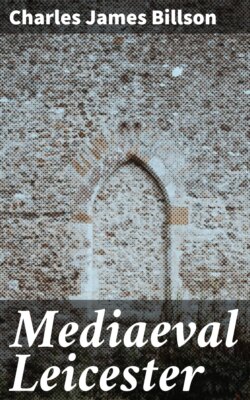Читать книгу Mediaeval Leicester - Charles James Billson - Страница 3
На сайте Литреса книга снята с продажи.
PREFACE.
ОглавлениеTable of Contents
IN the following pages an attempt has been made to gather together some information, concerning the ancient City of Leicester, which is now scattered over many volumes and documents, some of which are not readily accessible to the ordinary reader. A chapter has been added, for the sake of the student, giving references to the original authorities.
The book had its beginning in a Lecture on "Leicester in the Fourteenth Century," which I gave in the year 1897, at the request of the Leicester Museum Committee. A few years ago, I happened to find the notes of this old harangue, with the plans and illustrations of mediæval Leicester then prepared, all of which had been lying undisturbed for some twenty years. This discovery re-kindled my interest in the subject, and led to the studies now printed under the name of "Mediæval Leicester."
The title is not, I fear, very accurate; for the period which it is intended to cover really begins with the Conquest, and comprises the next 500 years, or thereabouts. In the strict language of historians, the Middle Ages came to an end in England with the last of the Plantagenets. The word "mediæval," is often extended, however, in popular usage, to the Tudor period; and it is in this sense that I have ventured to use it—indeed, in some cases, I must plead guilty to trespassing yet further into the modern era.
To all those who have helped me in the preparation of this book I am deeply indebted.
Without the enthusiastic co-operation of Mr. S. H. Skillington, who has grudged no pains to further its production, it would never have been published. He has helped me in every possible way, with so much knowledge and with such good-will that I cannot adequately express my thanks. I feel as the Trojans felt of yore, when they received the royal Carthaginian bounty—
"Grates persolvere dignas
Non opis est nostrae."
I am most grateful also to Mr. A. B. McDonald, A.R.C.A. (Lond.), of the Leicester School of Art, who has been very generous and successful in preparing plans and drawings, and in supervising the illustrations contained in the volume. I wish also to thank Col. C. F. Oliver, D.L., T.D., and all others who have so kindly helped with these embellishments, or who have allowed me to publish them; and I take this opportunity of congratulating both Mr. Newton and Mr. Keene on the good results of the photographic work entrusted to them.
I am under considerable obligations to Mr. Henry Hartopp, of Leicester, who has assisted me from the vast stores of his local knowledge; to Mr. A. Hamilton Thompson, M.A., F.S.A., who has given me much-appreciated help, chiefly in matters ecclesiological; to Mr. G. E. Kendall, A.R.I.B.A., who most obligingly made searches at the Public Record Office and elsewhere; to Mr. J. C. Challenor Smith, formerly Head of the Literary Department at Somerset House, who very kindly transcribed some original wills, and helped me in other ways; to the Mayor and Corporation of Leicester City, who readily gave me permission to print a translation of one of the unpublished documents preserved in their Muniment Room, and to publish an illustration of it; to the Venerable Archdeacon Stocks, D.D., who willingly transcribed and translated this document, and gave me other assistance; to Mr. H. A. Pritchard, the Town Clerk of Leicester; to Mr. T. H. Fosbrooke, F.S.A.; to Mr. H. M. Riley, of the Leicester Municipal Reference Library; to Mr. F. S. Herne, the Librarian of the Leicester Permanent Library, and to many others.
But those who are kind enough to help a lame dog over a stile are not answerable for his disability, and the mistakes and shortcomings of the book are all my own.
"Me, me, adsum qui feci, in me convertite ferrum!"
CHARLES JAMES BILLSON.
33, Saint Anne's Road,
Eastbourne,
October 14th, 1920.
